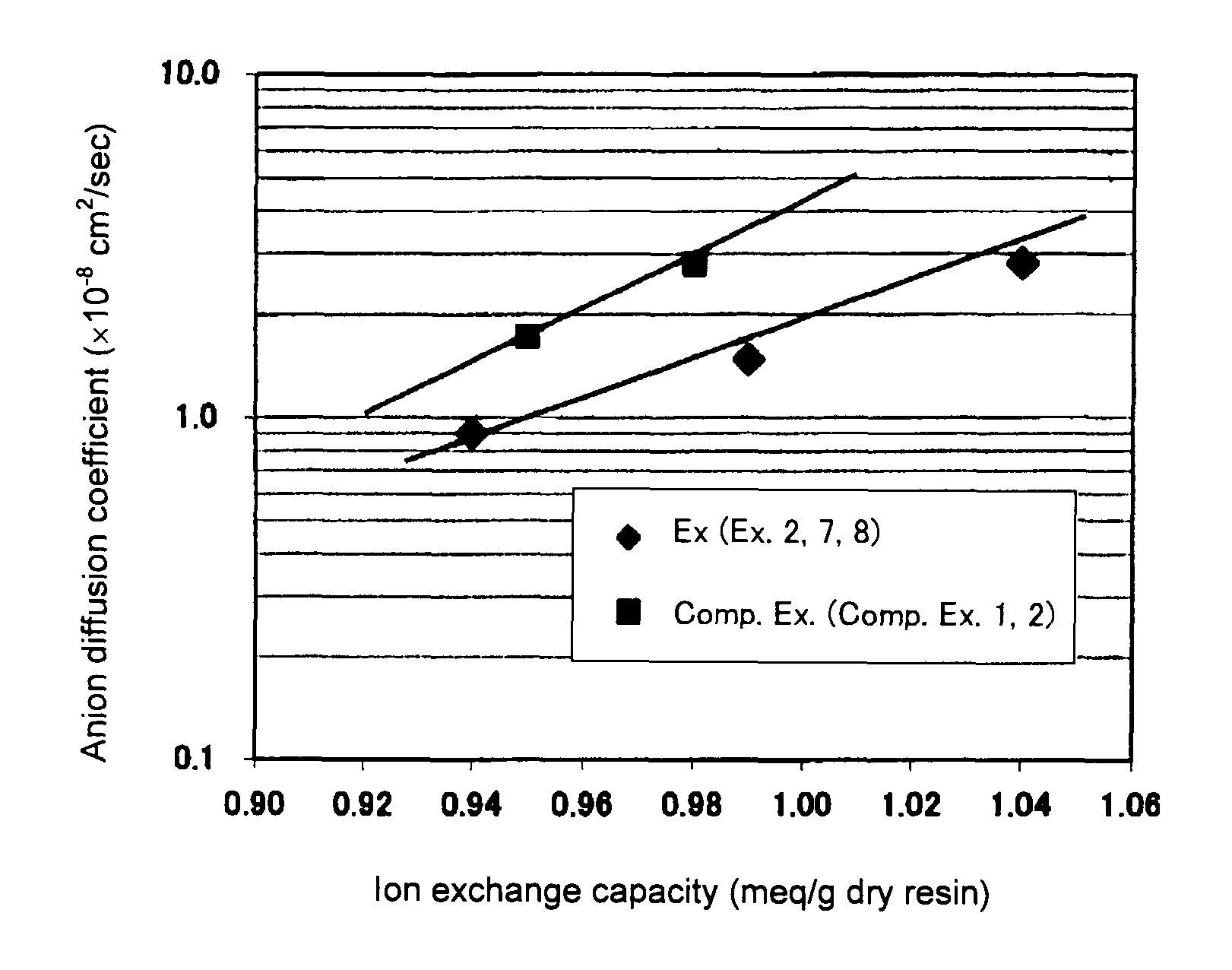Process for producing fluoropolymer, and fluorinated ion exchange membrane
a technology of ion exchange membrane and fluoropolymer, which is applied in the direction of ion-exchangers, cation exchanger materials, chemistry apparatus and processes, etc., can solve the problems of limited use and destruction of the ozone layer in the atmosphere, and achieve small global warming potential, small ozone depletion potential, and stable and efficient production
- Summary
- Abstract
- Description
- Claims
- Application Information
AI Technical Summary
Benefits of technology
Problems solved by technology
Method used
Image
Examples
example 1
[0115]A stainless steel reactor (autoclave) having an internal capacity of 0.2 liter (L) was evacuated of air, and in the reactor, a solution obtained by dissolving 37.2 mg of dimethyl-2,2′-azobisisobutyrate as a polymerization initiator in 59.2 g of C6H (CF3CF2CF2CF2CF2CF2H, H / F ratio: 0.076) as a polymerization medium, and 70.4 g of a perfluorovinyl ether compound having a carboxylic acid type functional group represented by the formula CF2═CFOCFCF(CF3)OCF2CF2COOCH3 were sucked and injected.
[0116]Then, to this reactor, tetrafluoroethylene (TFE) was introduced until the pressure in the reactor became 0.1 MPaG (gauge pressure), and the reactor was heated so that the temperature in the reactor became 60° C. After the temperature in the reactor was stabilized at 60° C., TFE was further introduced until the pressure became 1.20 MPaG, and the reaction was initiated. During the reaction, TFE was continuously introduced so as to maintain the pressure under 1.20 MPaG. When the amount of TF...
example 2
[0118]A stainless steel reactor (autoclave) having an internal capacity of 1 liter (L) was evacuated of air, and in the reactor, 315 g of C6H (CF3CF2CF2CF2CF2CF2H, H / F ratio: 0.076) as a polymerization medium and 174 g of perfluorovinyl ether compound having a carboxylic acid type functional group represented by the formula CF2═CFOCF2CF2CF2COOCH3 were respectively sucked and injected.
[0119]Then, TFE was introduced until the pressure in the reactor became 0.1 MPaG (gauge pressure), and the reactor was heated so that the temperature in the reactor became 70° C. After the temperature in the reactor was stabilized at 70° C., TFE was introduced until the pressure became 1.22 MPaG, and 63 g of a 0.38 mass % medium (CF3CF2CF2CF2CF2CF2H) solution of azobisisobutylonitrile as a polymerization initiator was injected and added in the reactor to initiate the reaction.
[0120]During the reaction, TFE was continuously introduced so as to maintain the pressure under 1.22 MPaG. Further, 10 g of a per...
example 3
[0122]A stainless steel reactor (autoclave) having an internal capacity of 0.2 liter (L) was evacuated of air, and in the reactor, a solution obtained by dissolving 45.2 mg of azobisisobutylonitrile as a polymerization initiator in 69.3 g of C6H (CF3CF2CF2CF2CF2CF2H, H / F ratio: 0.076) as a polymerization medium, and 53.7 g of a perfluorovinyl ether compound having a carboxylic acid type functional group represented by the formula CF2═CFOCF2CF2CF2OCF2CF2COOCH3 were sucked and injected.
[0123]Then, TFE was introduced until the pressure in the reactor became 0.1 MPaG (gauge pressure), and the reactor was heated so that the temperature in the reactor became 70° C. After the temperature in the reactor was stabilized at 70° C., TFE was further introduced until the pressure became 0.97 MPaG, and the reaction was initiated. Further, 4 g of a perfluorovinyl ether compound represented by the formula CF2═CFOCF2CF2CF2OCF2CF2COOCH3 was successively added in proportion to the amount of introductio...
PUM
| Property | Measurement | Unit |
|---|---|---|
| boiling point | aaaaa | aaaaa |
| temperature | aaaaa | aaaaa |
| temperature | aaaaa | aaaaa |
Abstract
Description
Claims
Application Information
 Login to View More
Login to View More - R&D
- Intellectual Property
- Life Sciences
- Materials
- Tech Scout
- Unparalleled Data Quality
- Higher Quality Content
- 60% Fewer Hallucinations
Browse by: Latest US Patents, China's latest patents, Technical Efficacy Thesaurus, Application Domain, Technology Topic, Popular Technical Reports.
© 2025 PatSnap. All rights reserved.Legal|Privacy policy|Modern Slavery Act Transparency Statement|Sitemap|About US| Contact US: help@patsnap.com


